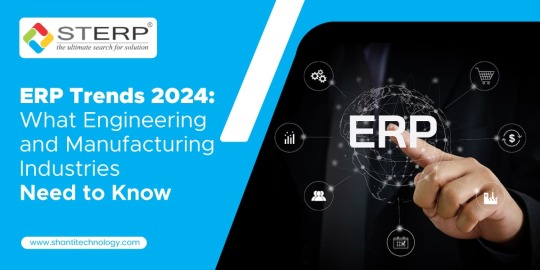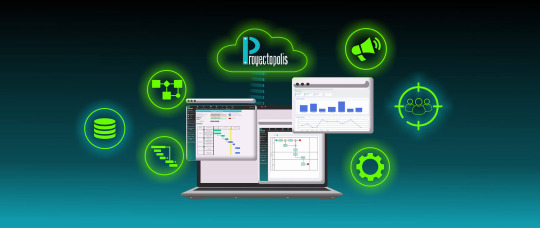#Management Software
Explore tagged Tumblr posts
Text
Property Management Software Pricing You Can Trust
Get transparent pricing on leading property management software solutions. Start managing your properties efficiently with eBox Tenants today!
2 notes
·
View notes
Text
ERP Trends 2024: What Engineering and Manufacturing Industries Need to Know
As we navigate through 2024, the landscape of Enterprise Resource Planning (ERP) systems continues to evolve, presenting both opportunities and challenges for engineering and manufacturing industries. Companies in this sector, especially those in key industrial regions like Maharashtra, Mumbai, Pune, and Gujarat, must stay abreast of the latest ERP trends to maintain competitive advantage and operational efficiency. In this blog, we’ll delve into the significant ERP trends of 2024 and their implications for the engineering and manufacturing sectors.

1. Increased Adoption of Cloud-Based ERP Solutions
One of the most significant trends in ERP software for engineering companies in Maharashtra and across India is the shift towards cloud-based solutions. Cloud ERP offers several advantages over traditional on-premise systems, including lower upfront costs, greater scalability, and enhanced accessibility.
Benefits of Cloud-Based ERP:
Cost Efficiency: Eliminates the need for expensive hardware and reduces IT maintenance costs.
Scalability: Easily adjusts to the growing needs of a manufacturing company in Gujarat or an engineering firm in Mumbai.
Accessibility: Provides access to real-time data from anywhere, facilitating better decision-making.
Leading ERP software companies in Pune are increasingly offering cloud-based solutions tailored to the needs of local engineering and manufacturing businesses. These solutions support remote work and ensure business continuity in an increasingly digital world.
2. Integration of AI and Machine Learning
Artificial Intelligence (AI) and Machine Learning (ML) are revolutionizing ERP systems by providing intelligent insights and automating routine tasks. For ERP software for engineering companies in Mumbai, integrating AI can enhance predictive maintenance, optimize supply chain management, and improve production planning.
AI and ML Applications in ERP:
Predictive Analytics: Helps foresee equipment failures and reduce downtime.
Supply Chain Optimization: Enhances demand forecasting and inventory management.
Process Automation: Automates repetitive tasks, freeing up human resources for more strategic roles.
ERP solution providers in Pune are at the forefront of integrating AI and ML into their systems, enabling companies to leverage advanced analytics and improve overall operational efficiency.
3. Emphasis on Cybersecurity
With the increasing digitization of manufacturing processes, cybersecurity has become a critical concern. ERP systems, being the backbone of business operations, are prime targets for cyber-attacks. Engineering and manufacturing companies in regions like Gujarat and Maharashtra need robust cybersecurity measures to protect their sensitive data.
Key Cybersecurity Features:
Data Encryption: Protects data during transmission and storage.
Multi-Factor Authentication: Enhances user authentication processes.
Regular Security Audits: Ensures continuous monitoring and improvement of security protocols.
ERP software for engineering companies in Maharashtra must incorporate these advanced security features to safeguard against data breaches and cyber threats.
4. Enhanced User Experience (UX)
User experience has become a critical factor in ERP adoption and utilization. Modern ERP systems are focusing on intuitive interfaces and user-friendly designs to ensure that all employees, regardless of their technical expertise, can effectively use the system.
UX Improvements:
Intuitive Dashboards: Provide real-time insights and easy navigation.
Mobile Accessibility: Ensures that users can access ERP data on-the-go.
Customization Options: Allow users to tailor the system to their specific needs.
ERP software companies in Pune are prioritizing user experience in their solutions, making it easier for engineering and manufacturing firms to train their staff and increase productivity.
5. Internet of Things (IoT) Integration
The integration of IoT with ERP systems is another trend transforming the manufacturing industry. IoT devices collect vast amounts of data from production lines, equipment, and other operational areas, which can be analyzed by the ERP system to optimize performance.
IoT Benefits in ERP:
Real-Time Monitoring: Provides immediate insights into production processes.
Predictive Maintenance: Schedules maintenance activities based on equipment condition rather than time intervals.
Enhanced Quality Control: Monitors product quality throughout the manufacturing process.
For ERP for manufacturing companies in Gujarat, IoT integration offers a significant advantage by improving efficiency and reducing operational costs.
6. Sustainability and Green Manufacturing
Sustainability is becoming a critical focus for manufacturing companies worldwide. ERP systems are evolving to support green manufacturing practices by tracking and optimizing resource usage, reducing waste, and ensuring compliance with environmental regulations.
Sustainable ERP Features:
Resource Management: Tracks energy and material usage to minimize waste.
Regulatory Compliance: Ensures adherence to environmental laws and standards.
Sustainability Reporting: Provides detailed reports on sustainability metrics.
Engineering and manufacturing companies in regions like Mumbai and Maharashtra can benefit from ERP solutions that incorporate sustainability features, helping them achieve their environmental goals and enhance their corporate reputation.
7. Modular and Flexible ERP Solutions
In response to the diverse needs of engineering and manufacturing firms, ERP solution providers in Pune are developing more modular and flexible ERP systems. These systems allow companies to select and implement only the modules they need, which can be easily scaled and customized as their business grows.
Advantages of Modular ERP:
Cost-Effective: Pay only for the features you need.
Scalability: Easily add new modules as your business requirements evolve.
Customization: Tailor the system to fit specific operational needs.
This trend is particularly beneficial for small to medium-sized enterprises (SMEs) in the engineering and manufacturing sectors, enabling them to adopt ERP systems without the burden of high costs or complexity.
8. Focus on Customer-Centric Manufacturing
ERP systems are increasingly supporting customer-centric manufacturing practices, where production processes are aligned with customer needs and preferences. This approach enhances customer satisfaction and drives business growth.
Customer-Centric ERP Features:
Custom Order Management: Handles unique customer requirements and specifications.
Enhanced CRM Integration: Integrates with customer relationship management (CRM) systems for a holistic view of customer interactions.
Real-Time Order Tracking: Provides customers with real-time updates on their orders.
Manufacturing companies in Gujarat and engineering firms in Maharashtra are leveraging these customer-centric ERP features to improve their service levels and build stronger customer relationships.
9. Advanced Analytics and Business Intelligence (BI)
Advanced analytics and BI are becoming integral components of modern ERP systems. These tools provide deep insights into business operations, helping companies make data-driven decisions and improve performance.
Key BI Features:
Data Visualization: Converts complex data into easy-to-understand charts and graphs.
Dashboards: Offer a real-time overview of key performance indicators (KPIs).
Predictive Analytics: Forecasts future trends based on historical data.
ERP software companies in Pune are incorporating advanced analytics and BI capabilities into their systems, empowering engineering and manufacturing firms to gain a competitive edge through better insights and informed decision-making.
10. Globalization and Localization Support
As engineering and manufacturing companies expand their operations globally, ERP systems must support multiple languages, currencies, and regulatory requirements. Globalization and localization features are essential for companies operating in diverse markets.
Globalization Features:
Multi-Language Support: Accommodates users from different regions.
Multi-Currency Handling: Manages transactions in various currencies.
Compliance with Local Regulations: Ensures adherence to regional laws and standards.
ERP solution providers in Pune and other industrial hubs are enhancing their systems to support global operations, enabling companies to seamlessly manage their international business processes.
Conclusion
The ERP landscape for engineering and manufacturing industries is rapidly evolving, driven by advancements in technology and changing business needs. Companies in Maharashtra, Mumbai, Pune, and Gujarat must stay informed about these trends to leverage the full potential of ERP systems. By adopting cloud-based solutions, integrating AI and IoT, prioritizing cybersecurity, and focusing on sustainability, businesses can achieve greater efficiency, competitiveness, and growth in 2024 and beyond.
For engineering and manufacturing firms looking for the best ERP software for engineering companies in Maharashtra or ERP for manufacturing companies in Gujarat, it is crucial to partner with leading ERP solution providers in Pune who understand the unique challenges and opportunities in this sector. Embracing these trends will not only enhance operational efficiency but also drive innovation and sustainability in the engineering and manufacturing industries.
By staying ahead of these ERP trends, companies can position themselves for success in an increasingly digital and interconnected world. Whether you are an engineering firm in Mumbai or a manufacturing company in Gujarat, the right ERP system can transform your operations and pave the way for a prosperous future.
#ERP software in Vadodara#Manufacturing ERP software in Gujarat#ERP software companies in Vadodara#ERP software providers in Vadodara#ERP for manufacturing company in Gujarat#ERP software#ERP system#cloud ERP#ERP solutions#software development#engineering ERP#management software#engineering services#engineering industry
5 notes
·
View notes
Text
Your Premier Choice for Manufacturing ERP Solutions in Vadodara, Gujarat | shantitechnology
Discover the power of streamlined operations with STERP (ShantiTechnology), the leading provider of cutting-edge ERP software solutions for manufacturing companies in Gujarat. Unlock efficiency, enhance productivity, and maximize profitability with our comprehensive suite of ERP tools. Join a league of industry leaders who trust STERP to transform their businesses in Vadodara and beyond. From seamless inventory management to real-time analytics, STERP empowers you to stay ahead in today's competitive landscape. Experience unparalleled support and customization options that cater to your unique business needs.
Unlock your company's full potential with STERP today.
#Manufacturing ERP software in Gujarat#ERP software companies in Vadodara#ERP software providers in Vadodara#ERP for manufacturing company in Gujarat#ERP software in Vadodara#ERP software#ERP system#cloud ERP#ERP solutions#ERP software for engineering#business process#management software#business and management#business analytics#business analyst#ERP India#Business Solutions#SAP Business One#Supply Chain Management#Go-To-Market
5 notes
·
View notes
Text
Going Paperless: How a School and Education Management Software is Transfiguring Administrative Processes

Discover how school and education management software are transforming the education sector towards a sustainable and efficient future by facilitating paperless administrative processes. Contact to know more: [email protected] or call us at +91 99425 76886.
#startup#school#school system#marketing#school software#education software#management software#school management software#education management software#preschool#preskool#software#development#application#apps#education#college#university#academia#institute
3 notes
·
View notes
Text
Client Management Software: The Ultimate Solution for Business Growth
Introduction
In today's competitive business landscape, maintaining strong client relationships is crucial for success. A well-structured Client Management Software (CMS) helps businesses efficiently manage customer interactions, streamline processes, and enhance overall client satisfaction. Whether you run a small business or a large enterprise, investing in a robust client management system can be a game-changer.
What is Client Management Software?
Client Management Software is a digital solution designed to organize, track, and manage customer interactions, data, and communication. It enables businesses to maintain a centralized client database, automate workflows, and enhance collaboration between teams.
A well-designed CMS helps companies improve customer relationships by providing real-time access to client details, transaction history, preferences, and communications, ensuring a seamless experience for both the business and the customer.
Key Features of Client Management Software
1. Centralized Customer Database
A client management system stores all customer-related information, such as contact details, purchase history, preferences, and communication logs in one place. This allows businesses to have a 360-degree view of their clients, making interactions more personalized and efficient.
2. Automated Task Management
The software automates repetitive tasks like follow-up emails, appointment scheduling, and reminders. This saves time and ensures that no important tasks are missed.
3. Communication Tracking
Keeping track of client interactions across multiple channels (emails, calls, chats, and social media) is essential for personalized service. A CMS records all communication, ensuring smooth and transparent client interactions.
4. Lead and Sales Management
A good CMS helps businesses track potential clients, convert leads into sales, and manage the entire sales pipeline efficiently. It provides insights into sales trends and customer behaviors, helping businesses optimize their sales strategies.
5. Billing and Invoicing Integration
Many client management tools come with billing and invoicing features that allow businesses to generate invoices, track payments, and manage financial transactions efficiently.
6. Customer Support and Ticketing System
Client management software often includes a ticketing system that helps businesses handle customer queries, complaints, and support requests efficiently, improving customer satisfaction.
7. Data Security and Compliance
With increasing concerns about data privacy, CMS ensures that customer data is stored securely and complies with industry regulations such as GDPR, HIPAA, and others.
Benefits of Using Client Management Software
1. Improved Customer Relationships
By maintaining detailed client records and tracking interactions, businesses can personalize their approach, anticipate customer needs, and build stronger relationships.
2. Enhanced Productivity and Efficiency
Automation of tasks and seamless communication tools help teams work more efficiently, reducing manual efforts and saving valuable time.
3. Better Decision-Making
Real-time data analytics and reporting provide valuable insights into customer behavior, sales performance, and business growth, enabling informed decision-making.
4. Streamlined Workflow and Collaboration
A centralized system ensures that all departments, including sales, marketing, and customer service, have access to the same data, improving collaboration and workflow management.
5. Increased Sales and Revenue
With efficient lead tracking, follow-ups, and sales pipeline management, businesses can convert more prospects into loyal customers, ultimately boosting revenue.
6. Cost Savings
Automating customer management processes reduces the need for additional staff and minimizes operational costs, making the business more profitable in the long run.
Choosing the Right Client Management Software
When selecting the best CMS for your business, consider the following factors:
Ease of Use: The software should have an intuitive interface and require minimal training for your team.
Scalability: Ensure that the software can grow with your business needs.
Integration: It should seamlessly integrate with existing tools like CRM, email marketing platforms, and accounting software.
Customization: Choose a system that allows customization to suit your specific business requirements.
Security: Opt for a CMS that offers strong data protection and complies with industry regulations.
Customer Support: Reliable customer support is essential for troubleshooting and smooth implementation.
Conclusion
Client Management Software is an essential tool for businesses looking to streamline operations, enhance customer relationships, and drive growth. By investing in the right CMS, companies can improve efficiency, increase revenue, and stay ahead of the competition. Whether you're a startup or a well-established business, implementing a reliable client management system can transform the way you engage with your customers and scale your business.
0 notes
Text
#process street#business software#business management software#workflows#management software#esign docs#docs
0 notes
Text
Why do small and medium-sized businesses need field service management software
Small and medium-sized businesses need field service management software to streamline operations, improve scheduling, and enhance customer satisfaction. It reduces paperwork, optimizes workforce efficiency, and boosts profitability. Swivl Tech provides smart solutions to automate job tracking, invoicing, and team coordination, helping businesses scale with ease. Upgrade your field service management today!
0 notes
Text
Why Employee Goal Management Software is a Game-Changer for Your Organization
Employee goal management software revolutionizes how organizations track and achieve their goals. By offering clear visibility into employee progress and facilitating transparent communication, these platforms encourage better alignment of team objectives with overall business goals. The software helps employees stay motivated, focused, and accountable while enabling managers to provide regular feedback and support. In today’s fast-paced business environment, leveraging goal management software is a game-changer, enhancing productivity, driving engagement, and ensuring organizational success. Discover how it can transform your workplace.

0 notes
Text
Meet the Trusted ERP Software Provider for Manufacturers | STERP | shantitechnology
Introducing Shantitechnology (STERP), a visionary leader among ERP software companies in India. As one of the top ERP software providers in the country, they have revolutionized the business landscape with their cutting-edge solutions. Specializing in ERP for manufacturing companies in India, Shantitechnology offers a comprehensive suite of tools tailored to streamline operations, enhance productivity, and boost profitability. Their expertise in ERP software in India is unparalleled, providing seamless integration, real-time data analytics, and advanced reporting capabilities.
With a track record of empowering businesses across various sectors, Shantitechnology is the go-to ERP software company in India for those seeking sustainable growth and operational excellence. Experience the future of ERP solutions with Shantitechnology (STERP) today.

#ERP software Companies in India#ERP software providers in India#ERP for manufacturing company in India#ERP software in India#ERP software company in India#technology#marketing#ERP software#cloud ERP#ERP solutions#manufacturer#business process#management software#business and management#business analytics#business#STERP#shantitechnology
8 notes
·
View notes
Text
Why Is Customer Relationship Management So Important for your business?
0 notes
Text
Management software for companies
Can you imagine having a management software that not only allows you to organize projects, but also to improve each stage of the business processes in a single platform in the cloud? At Proyectopolis, we have developed a complete solution for the administration, organization, planning, and execution of projects, especially designed for companies seeking efficiency and control in their operations.

With our business management software, driven by the BPM (Business Process Management) methodology, you will have the ideal tool to manage both productivity and cost reduction in your organization.
What is management software, and why is it essential?
A management software is a technological platform that centralizes and optimizes your company's resources, from project management to business process management and team administration. This type of tool is essential for any modern company that wants to adapt to changes and optimize its business processes.
With Proyectopolis project management software, companies can achieve better visibility of each stage of their projects and have full control of the specific needs in each area. In addition, it provides the ideal structure for connecting departments and facilitates comprehensive project management in one place.
How management software improves productivity
Productivity is key to success, and with Proyectopolis software, companies will be able to optimize the performance of their teams and processes, eliminating inefficiencies and increasing the speed of decision-making. How do we achieve this?
Centralization of information. All relevant data is in one place, avoiding errors and duplications.
Task automation. Automate routine processes, so your team can focus on strategic activities.
Real-time reporting. Visualize the status of each process and make more informed decisions.
This platform also enables more effective supply chain management and optimizes workflow between teams, resulting in a noticeable increase in productivity and a clearer focus on the company's overall strategy.
Areas of application
Proyectopolis software offers solutions adaptable to different areas, integrating functionalities that respond to the specific needs of each department:
Maintenance software
With this module, you can efficiently manage your physical and technological resources, monitoring the state of your assets and scheduling preventive maintenance, which contributes to cost reduction.
Sales and marketing management software
Proyectopolis facilitates the organization of campaigns and the measurement of results. From lead control to strategy planning, this module will help you align your sales and marketing team to improve results.

Project management software
Our project management software provides a detailed structure for each project, from assigning tasks to tracking deadlines. Perfect for efficient and coordinated project management.
Process software
Optimize every step of business processes, from planning to execution, using the BPM methodology. This module allows you to improve workflow and ensure that each task meets your company's quality standards.
Experience our software
At Proyectopolis we are committed to the success of your company. Take advantage of a business management software that adapts to your specific needs. Create now with us and transform the way you manage your business!
0 notes
Text
0 notes
Text

I’ve been working in an edtech brand for a long time, and one thing I always noticed was the communication gap across departments. It was hard to stay connected, and sharing files, especially confidential ones, was a huge challenge. One day, while scrolling through Instagram, I came across an ad for an ERP software called biCanvas. I thought it might help, so I brought it up with my manager, and we decided to give it a try.
Honestly, it was so easy to understand and manage. It really solved a lot of our problems. We could communicate better, share files securely, and the best part? Our productivity increased by 67%! It was honestly amazing to see such a big improvement. It made me realize that sometimes, making the right investment can really help your business grow.
#instagram#likeforlikes#tumblraesthetic#likes#tumblrpost#india#services#service#ERP software#edTech#management software#pune#local#viral#trend#newpost
1 note
·
View note
Text
Corebility: All-in-One Personal Trainer Management Software to Streamline Your Studio.

Simplify your fitness business with Corebility, the all-in-one personal trainer management software. Effortlessly manage client accounts, schedule sessions, design home exercise programs, and grow your Pilates, Yoga, or Personal Training studio with ease.
0 notes
Text
0 notes